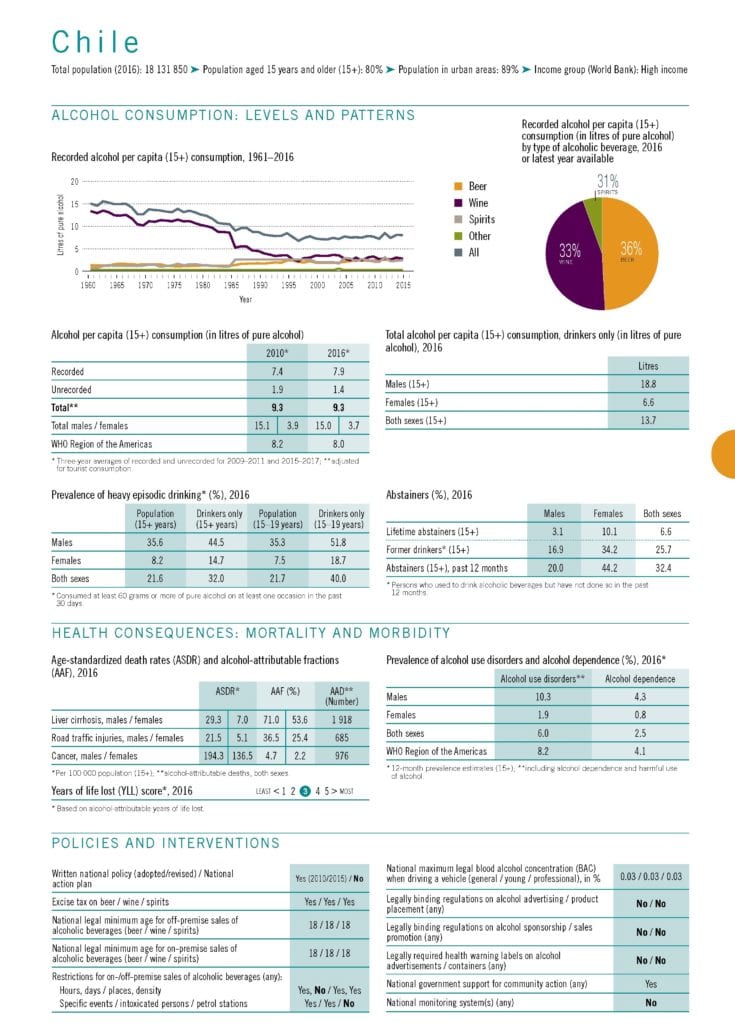The National Service for the Prevention and Rehabilitation of Drug and Alcohol Consumption released the results of the II Study of Drugs in Higher Education. The study collected data between August and September 2021, from 26,155 students in universities, professional institutes, and technical training centers via an online survey.
The study results in brief
Alcohol use
- Alcohol was the most used drug by higher education students.
- 6 out of every 10 students (60.8%) reported past month alcohol use.
- Among male students 64.6% reported past month alcohol use.
- Among female students 62% reported past month alcohol use.
- From among the students with past-month alcohol consumption, two-thirds (62.9%) reported getting intoxicated at least once in the same period.
- This is a higher average than for the general population (50.2%).
- Alcohol use was highest among students aged 23 to 24 years.
- Only 1 in 10 (13.9%) students considers it risky to consume three or more alcoholic beverages on one occasion.
Other drug use
- One-third of higher education students (31.6%) reported using cannabis in the last year.
- Almost half (45%) said that they were offered marijuana in the same period.
- Consumption of tranquilizers was at 4.5%.
Álvaro Castillo, director of the Millennium Center for the Evaluation and Analysis of Drug Policies (MEAD), explains that the results show a concerning pattern and recurring behavior. Mr Castillo emphasizes that the growing number of young women who are consuming alcohol is especially concerning.
The gender gap has been narrowing,” said Álvaro Castillo, director of the Millennium Center for the Evaluation and Analysis of Drug Policies (MEAD), as per El Mercurio.
Unfortunately, it is not because they have reduced their consumption, but because they have tended to equalize male consumption.”
Álvaro Castillo, director, Millennium Center for the Evaluation and Analysis of Drug Policies (MEAD)
The prevalence of [alcohol] consumption and intoxication is practically similar between men and women, which is worrying because they have a lower tolerance to the negative effects of alcohol and from lower consumption,” warns Carlos Ibáñez, an academic at the Department of Psychiatry and Mental Health of the Faculty of Medicine of the University of Chile, as per El Mercurio.
Carlos Ibáñez, academic, Department of Psychiatry and Mental Health, Faculty of Medicine, University of Chile
Alcohol norm, harm, and policy in Chile
Alcohol is more normalized since it is a legal substance that is heavily marketed and widely and easily available. This is specifically true for young people, according to Francisca Oblitas, the spokeswoman for The National Service for the Prevention and Rehabilitation of Drug and Alcohol Consumption.
Mr. Castillo explains that the acceptability, availability, and normalization of alcohol in Chile is a problem because alcohol is linked with a higher probability of injuries, accidents, and exposure to risky behaviors and situations. He refers to data from the World Health Organization which shows that 13% of deaths among the young population in Chile are due to alcohol.
“It is important to reinforce the idea that alcohol is the most consumed substance and the one that generates the most health problems in the country,” said Carlos Ibáñez of the University of Chile, as per El Mercurio.
Carlos Ibáñez, academic, Department of Psychiatry and Mental Health, Faculty of Medicine, University of Chile
According to WHO data in 2016, in Chile, over two-thirds of young people between 15 to 19 years (40%) who use alcohol engage in binge alcohol use. Early initiation to alcohol and high-risk patterns of alcohol use at an early age is highly problematic for people, communities, and society overall. For example, a large number Chilean adult men already suffer from alcohol use disorder (10.3%) and alcohol dependence (4.3) – this is a higher rate compared to the average in the WHO Americas region. And early alcohol initiation fuels this vicious cycle.
The results of the new study provide the basis and clear case for urgent action for improving alcohol policy in Chile. The study results can also be used by higher education institutions to take action for the prevention of the alcoholization of academic environments at the local level.
Francisca Oblitas says that The National Service for the Prevention and Rehabilitation of Drug and Alcohol Consumption offers advice and orientation courses on policy solutions and interventions at the local level which can target individual consumption and change the environment via preventive policies.

